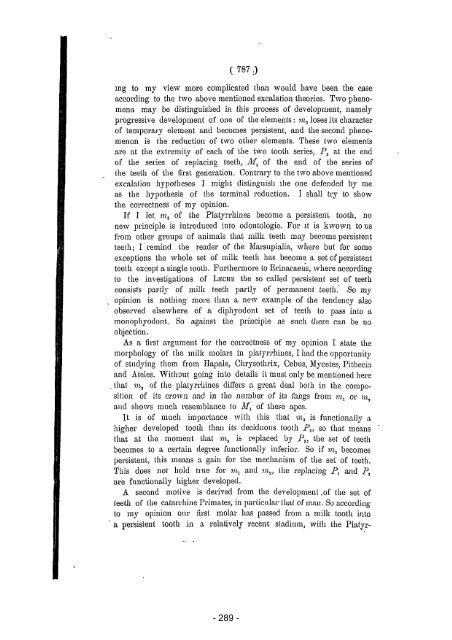Proceedings of the section of sciences - DWC - KNAW
Proceedings of the section of sciences - DWC - KNAW
Proceedings of the section of sciences - DWC - KNAW
Create successful ePaper yourself
Turn your PDF publications into a flip-book with our unique Google optimized e-Paper software.
- 289 -<br />
( 787 J<br />
mg to my view more complicated tban would have been <strong>the</strong> case<br />
according to <strong>the</strong> two above mentioned excalation <strong>the</strong>ories. Two phenomena<br />
may be distinguished in this process <strong>of</strong> development, namely<br />
progressive development <strong>of</strong> one <strong>of</strong> <strong>the</strong> elements: 1I2 3 10ses Hs character<br />
<strong>of</strong> temporary element and becomes persistent, and <strong>the</strong> second phenomenon<br />
is <strong>the</strong> reduction <strong>of</strong> two o<strong>the</strong>r elements. These two elements<br />
are at <strong>the</strong> extl'emity <strong>of</strong> each <strong>of</strong> <strong>the</strong> two tooth series) P8 at <strong>the</strong> end<br />
<strong>of</strong> <strong>the</strong> series <strong>of</strong> replacing teeth, M3 <strong>of</strong> <strong>the</strong> end <strong>of</strong> <strong>the</strong> series <strong>of</strong><br />
(he teeth <strong>of</strong> <strong>the</strong> first generation. Oontrary to <strong>the</strong> two above mentioned<br />
excalation hypo<strong>the</strong>ses 1 might clistinguish <strong>the</strong> one defencled by me<br />
as <strong>the</strong> hypo<strong>the</strong>sis <strong>of</strong> <strong>the</strong> terminal reduction. I sha11 try to show<br />
<strong>the</strong> correctness <strong>of</strong> my opinion.<br />
If I let ma <strong>of</strong> <strong>the</strong> Platyrrhines become a persistent tooth, no<br />
new principle is introduced into odontologie. For It is kwown to us<br />
from otbel' groups <strong>of</strong> animals that milk teeth may become persistent<br />
teeth; I remind <strong>the</strong> reader <strong>of</strong> <strong>the</strong> lVIarsupiaJia, where but tor some<br />
exceptions <strong>the</strong> whole set <strong>of</strong> milk teeih has become a set <strong>of</strong> persistent<br />
teeih except a single looth. Fur<strong>the</strong>rmore to Erinacaells, where according<br />
to <strong>the</strong> investigations <strong>of</strong> LEeR!!: <strong>the</strong> sa called persistent set <strong>of</strong> teeth<br />
consists partly <strong>of</strong> mille teeth partly <strong>of</strong> permanent teeth: 80 my<br />
opinion is nothing more (han a. new example <strong>of</strong> <strong>the</strong> tendency a1so<br />
observed e1se,vhere <strong>of</strong> a diphyodont set <strong>of</strong> teeth to pass into a<br />
monophyodont. 80 against <strong>the</strong> principle as snch <strong>the</strong>re ean be no<br />
objection.<br />
As a first argument fol' <strong>the</strong> correctness <strong>of</strong> my opinion I state <strong>the</strong><br />
morphology <strong>of</strong> tIle mille 11101a1's in platYl'l'hiues, I had <strong>the</strong> opportunity<br />
<strong>of</strong> stndying <strong>the</strong>m from Hapale, Ohrysothrix, Oebus, Mycetes, Pi<strong>the</strong>cia<br />
and Ateles. Without going into details it must only be mentioned here<br />
_ that m'3 <strong>of</strong> <strong>the</strong> platyrrhines clifIers a great deal both in <strong>the</strong> composition<br />
<strong>of</strong> its crown and jn <strong>the</strong> l1umber <strong>of</strong> its t"angs from ?n 1 or 177"<br />
allel shows much resemblance to 'trIl <strong>of</strong> <strong>the</strong>se apes.<br />
lt is <strong>of</strong> much imporiance with this that '/11 3 is fnnctionally a<br />
lligher developed tooth th all its decidllons tooth Pa, sa that means<br />
that at <strong>the</strong> moment that ma ió replaced by P 3 ) <strong>the</strong> set <strong>of</strong> teeth<br />
becomes to a certain degree fllJlctionally inferiol'. So jf ?na becomes<br />
persistent, this means a gain for <strong>the</strong> mechanism <strong>of</strong> <strong>the</strong> set <strong>of</strong> teetl1.<br />
This does not hold tl'ne fol' 1)/,1 anel ?n 2 , ihe l'eplacing P1 and P 2<br />
are fnnctionally higher developed.<br />
A second motive is derived from <strong>the</strong> development .<strong>of</strong> <strong>the</strong> set <strong>of</strong><br />
teeth <strong>of</strong> ihe catanhine Primates, in parLiclllar thai <strong>of</strong> man. So accol'ding<br />
to my opinion our firs! molar has passed from a mille tooth into<br />
. a persistent tooth in a l'elatively recent stadium, with <strong>the</strong> PlatJ:1'-

















